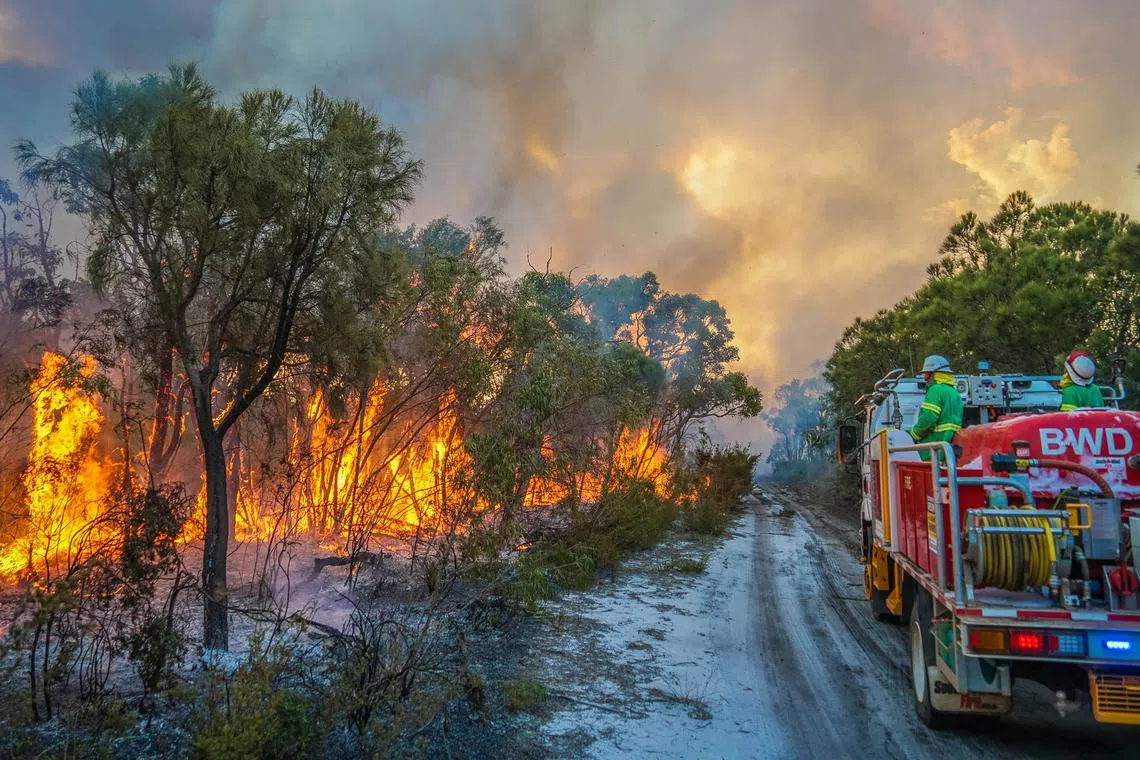Australia faces ‘explosive’ fire risk after years of rain: Report
Sign up now: Get insights on Asia's fast-moving developments

Emergency services personnel fighting a fire near Margaret River on Dec 8, 2021. A report is warning that Australia is at the risk of major wildfires in 2023-2024.
PHOTO: AFP/WESTERN AUSTRALIA DEPARTMENT OF FIRE AND EMERGENCY SERVICES
Follow topic:
SINGAPORE – The Australian authorities need to urgently prepare for the risk of major wildfires after three years of excessive rainfall triggered massive vegetation growth, creating “powder-keg” conditions for grass fires, a report said.
Written by the Climate Council and the Emergency Leaders for Climate Action (Elca), the report said wetter-than-average conditions, including record-breaking rainfall and floods
But the wet conditions have eased and hot conditions are drying out grasslands and forests, said the report released on Wednesday.
“Excessive rainfall in recent years has caused prolific vegetation growth in Australia, which is now drying and turning into fire fuel as we experience hotter, drier conditions,” said co-author Greg Mullins, former commissioner of fire and rescue in New South Wales and founder of Elca.
Elca is a coalition of 40 former chiefs, commissioners and directors-general of fire and emergency services across the country. The Climate Council is a non-governmental group focusing on climate science communication and solutions.
Mr Mullins said the summer of 2023 to 2024 will almost certainly see a return to normal or above-normal bushfire conditions across most of Australia.
He said previous long wet periods were followed by major fires in parts of Australia, including around Sydney.
“All levels of government need to understand the escalating risk of devastating fires and ramp up preparedness now,” he added.
La Nina is a climate pattern in the tropical Pacific Ocean that brings cooler and wetter weather to the region. The alternate state, El Nino, leads to hotter and drier conditions,
But because of climate change, hotter temperatures mean fires can occur even during the years with no El Nino episodes.
“Australia’s protracted La Nina episode is giving way to hotter and drier conditions, including the possible formation of an El Nino event. As a result, we will almost certainly see a return to normal or above normal fire conditions across most of Australia in coming months,” said the report.
Australia experienced three protracted La Nina episodes in 1954 to 1957; 1973 to 1976; and 1998 to 2001. After each of these events came extensive grass fires across Australia, followed by major forest fires causing loss of life and property on the east coast, particularly in New South Wales, said the report.
Australia’s most widespread grass fires occurred from 1974 to 1975, with about 117 million ha burned nationally – about 15 per cent of the country’s land mass.
The report’s warning comes as fears grow that a strong El Nino event in coming months could lead to a repeat of the catastrophic Black Summer wildfires of 2019 to 2020.
Over several months, hundreds of fires burned a record 24 million ha, killing 33 people, destroying more than 3,000 homes and causing billions of dollars in losses. Nearly three billion animals were also killed or displaced.
The fires were made worse by severe drought and extreme temperatures that made conditions ripe for the record blazes.

A New South Wales Rural Fire Service officer monitoring a bushfire along the Old Hume Highway near the town of Tahmoor, New South Wales, on Dec 19, 2019.
PHOTO: EPA-EFE
And there are fears that a worse disaster could happen.
“Firefighters fear that grass fires occurring in hot, dry and windy conditions worsened by climate change could unfold on a scale never before experienced,” Mr Mullins said, adding that this could potentially overwhelm emergency services and place communities at great risk.
Among the recommendations, the authors said emergency services and land management agencies need more funding to respond to escalating disasters, as well as more full-time staff and volunteers. And there needs to be much stronger action to cut greenhouse gas emissions that are fuelling more extreme weather.
“Governments at all levels must collaborate to reverse the funding trend that sees most disaster-related funds going towards response and recovery, by increasing public investment in adaptation and resilience,” the authors added.
The report said the extreme grass fire that swept through Marshall,
Tens of thousands of residents were forced to flee the fire, which was driven by hurricane-force winds and an extreme drought that dried out the landscape. About 1,100 homes were destroyed and one person was killed in a single afternoon.


